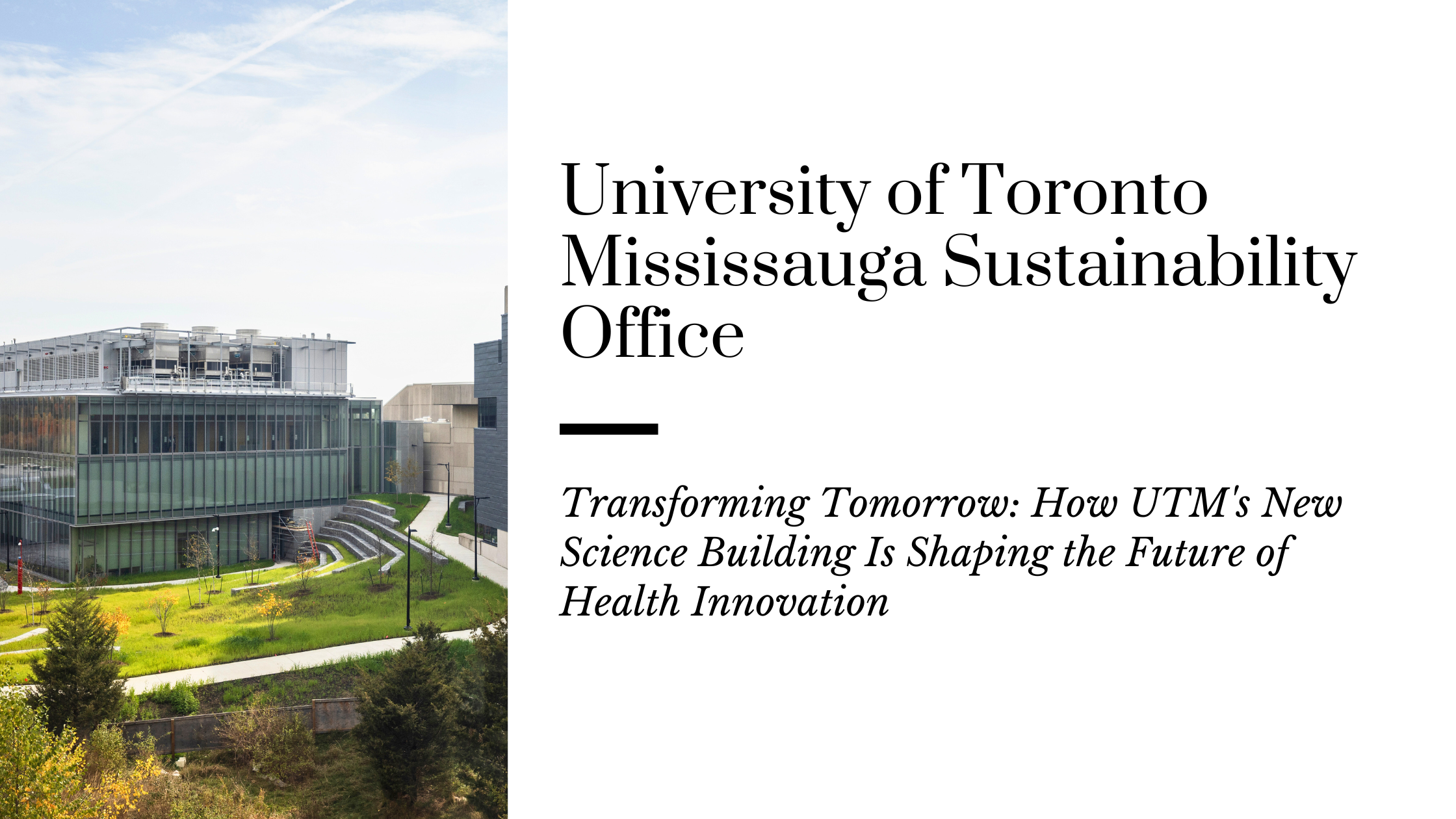
This past fall, the University of Toronto Mississauga (UTM) proudly unveiled its new science building, a major milestone in sustainable infrastructure. Designed to meet the university’s highest performance standards, the facility stands as one of North America’s most energy-efficient biological and chemical laboratory buildings. Among its many initiatives is SpinUp, an incubator that empowers early-stage health and life sciences startups with the infrastructure, equipment, and programming needed to develop their IP and scale their growth.
In January 2025, we had the privilege of speaking with Raquel De Souza and Beverley Ayeni about the impact of the new science building and the SpinUp initiative. Their commitment to fostering sustainability and innovation will be recognized at the PSG Gala, where they will receive the prestigious Sustainability Award—an honour that has celebrated outstanding contributions to environmental progress in the Canadian pharmaceutical industry since 2022.
To highlight their achievements, we spoke with Raquel and Beverley about how UTM is shaping a dynamic, forward-thinking environment where sustainability and collaboration drive the future of scientific innovation. Here’s what they had to share:
What inspired the development of the new science building, and how does it align with UTM’s vision for innovation in life sciences?
Raquel De Souza: The new science building was designed to advance the university’s academic research priorities by creating a space that supports not only individual departments but also fosters interdisciplinary collaboration. With open-concept laboratories and shared equipment rooms, the building naturally encourages interaction between research groups from different disciplines. Researchers can’t help but cross paths, exchange ideas, and discover opportunities for collaboration.
These shared spaces provide faculty and graduate students access to state-of-the-art research infrastructure and support services, breathing new life into programs that have outgrown existing campus facilities. Additional space becomes crucial as research groups expand and attract graduate students. This building was designed to meet that demand, ensuring that groundbreaking research can continue to thrive in an environment built for innovation and discovery.
What are the key features of UTM’s new science building, and how do they enhance life science research and education?
Beverley Ayeni: Our new science building is one of North America’s most energy-efficient biological and chemical laboratory facilities. Designed to meet the university’s highest performance standards, it reflects our deep commitment to sustainability and innovation in building design.
On track for LEED Gold certification, the building plays a key role in our broader goal of reducing our carbon footprint and creating a climate-positive campus. About a year and a half ago, we launched our Climate Positive Plan, which outlines our commitment to cutting greenhouse gas emissions by 39% by 2030, achieving carbon neutrality by 2043, and ultimately becoming climate-positive by 2050.
Laboratory-intensive buildings typically have high energy demands, but this new facility was designed to challenge that norm. A geothermal field helps regulate heating and cooling, while solar photovoltaics generate renewable energy. An advanced HVAC system improves efficiency, a rainwater harvesting system supports water conservation and features like a green roof, heat island reduction strategies, and daylight harvesting contribute to an overall lower environmental impact.
What is a geothermal field, and why is its inclusion in the new science building’s design significant for sustainability?
B.A: A geothermal system harnesses heat stored beneath the Earth’s surface to provide efficient, sustainable heating and cooling for a building. It works through a network of underground pipes filled with a circulating fluid—usually water mixed with a small amount of antifreeze—to transfer heat. During colder months, the system absorbs heat from the ground and moves it into the building, while in warmer months, it does the reverse, drawing heat from the building and storing it underground.
In our case, the system consists of approximately 178 boreholes drilled 320 feet deep, each containing pipes that facilitate this heat exchange. This setup supplies about 75% of the building’s total heating and cooling energy load, significantly reducing our reliance on conventional HVAC systems.
Beyond its practical benefits, the geothermal system serves as a living lab for students and faculty, offering hands-on learning about sustainable technologies, energy efficiency, and system maintenance. Capitalizing on the Earth’s stable underground temperatures has reduced overall energy consumption, minimized utility and maintenance costs, and created a long-term model for cost-effective, eco-friendly building design.
How does the building’s energy-reducing HVAC system compare to traditional systems regarding cost savings and environmental benefits?
B.A: Our HVAC initiatives have set a new benchmark for sustainability, significantly improving energy efficiency and reducing environmental impact. The building operates with approximately 55% less energy use intensity—a key metric that measures energy consumption relative to building size. This reduction is expected to translate into a 35% decrease in energy costs and a 70% drop in carbon emissions compared to a conventional building designed to meet baseline energy standards.
These efficiencies align with ASHRAE 90.1, the industry standard established by the American Society of Heating, Refrigeration, and Air Conditioning Engineers, which defines the minimum energy performance requirements for commercial buildings. By exceeding these standards, our building serves as a model for sustainable design, helping to shape the future of energy-conscious architecture.
How does this building position UTM as a sustainability-focused research and innovation leader in Canada?
B.A: Beyond its geothermal system, the building incorporates renewable energy sources like solar power and high-performance materials, showcasing UTM’s innovative energy management and sustainable architecture approach. More than just an academic space, it functions as a living research lab—a place where students, faculty, and industry professionals can engage with sustainability in real time.
Designed with collaboration in mind, the building fosters an environment where researchers, faculty, and students work together to tackle real-world environmental challenges. It reinforces UTM’s role at the forefront of sustainability research, attracting top-tier talent and inspiring the next generation of leaders in the field.
Which specific departments or research areas are expected to benefit most from the new science building and how?
R.D.S: The new science building is home to a diverse range of departments and initiatives, each designed to push the boundaries of research and innovation. Among them is the Centre for Medicinal Chemistry, an interdisciplinary initiative that brings together researchers to accelerate drug development, focusing on cancer and rare diseases. The building also houses SpinUp, the university’s first wet lab incubator, created to fill a critical gap in life sciences entrepreneurship by providing flexible lab space and tailored programming to help early-stage startups thrive.
Another key initiative is the Novo Nordisk Network for Healthy Populations, a collaboration between UTM, the Dalla Lana School of Public Health, and the Temerty Faculty of Medicine. This initiative combines research with community engagement to influence policy, advance diabetes research, and expand education and outreach efforts in the Peel Region and beyond. The building is also home to UTM’s Forensic Science Program, the oldest program of its kind in Canada.
How does SpinUp’s co-working wet lab space promote sustainability, foster innovation, and facilitate collaboration among resident startups?
R.D.S: SpinUp was created as a dedicated hub for researchers looking to commercialize their lab-based innovations and launch startups. Our mission is to empower these innovators by providing the resources, programming, and connections they need to establish and grow their ventures while addressing the key challenges many early-stage startups face.
Designed with sustainability in mind, the SpinUp lab space maximizes efficiency, accommodating up to 23 early-stage startups within a footprint that typically houses just two to four research groups. The open-concept layout allows each startup to have its dedicated footprint while fostering a highly collaborative environment. Since launching in May 2024, SpinUp has already seen most startups engage in collaborative projects, sharing equipment, expertise, and network connections. More than just a co-working space, SpinUp was designed to cultivate a thriving, supportive community.
The lab is built to handle heavy chemistry work and equipped with 35 fume hoods, including a full-length fume hood for scale-up experiments and large rotovap cabinets. It also houses three containment level 2 spaces for bacterial and mammalian cell and tissue culture. This versatility allows SpinUp to support startups working across various life sciences applications, from small molecule therapeutics and biologics to diagnostics, drug delivery, and beyond.
What specific resources and facilities does SpinUp offer early-stage life sciences startups, and how does it address key gaps in the journey from concept to a successful company?
R.D.S: With SpinUp, we’ve designed a program to help startups focus their limited resources as they get off the ground. Early-stage companies have limited capital, so we wanted to ensure they could dedicate as much of their resources as possible to refining and developing their intellectual property. Our founder-friendly incubation model offers access to wet lab space and equipment at highly subsidized rates, essential building amenities and full operational support. This includes bio and chemical permitting, waste management, and other services the university handles, making it easy for them to focus on innovation.
We also partner with lab supply companies to provide discounted rates on reagents and consumables, helping our startups keep costs down. In addition to the lab space, we offer access to co-working office space and a comprehensive curriculum to guide startups through their entrepreneurial journey. Our goal is to prepare them for the next stage, where they can attract the capital they need to grow and transition to larger commercial spaces.
Through webinars, workshops, and one-on-one office hours with our ecosystem partners, we provide valuable insights on intellectual property strategy, product development, regulatory considerations, and fundraising topics. We teach our startups how to pitch, when, and how to tailor their approach for different investors—whether it’s an angel investor, a VC, or a strategic partner. We also cover technology considerations, such as data privacy, especially for those working in healthcare. Our program is designed to be comprehensive and supportive at every stage.
One of our standout initiatives is the Blue Ticket program, which leverages strategic collaborations with global industry leaders like Merck and AbbVie. The Blue Ticket supports the commercialization and scaling of innovative solutions emerging from SpinUp to benefit healthcare and the biotech industry. Startups selected for the program receive tailored business and scientific mentorship from the sponsoring partner, as well as one year of free membership at SpinUp, including dedicated lab space and access to all the resources and support we offer.
What success stories have emerged from startups that have been incubated at SpinUp?
R.D.S: Since officially launching in May 2024, our startups have achieved significant milestones. Arma Biosciences, founded from U of T Faculty of Pharmacy research, secured $1.2 million USD in financing, filed a new provisional patent, and received a multimillion-dollar DHA for real-time biomarker assessment in diagnostics.
Xatoms, led by U of T undergraduates, competed in the global Hult Prize finals, ranking in the top six out of 10,000 companies. They also won a record-breaking $500,000 at Startup Fest—the highest cumulative award amount in the event’s history.
Mesosil secured $2.2 million in Canadian seed funding to continue developing their infection-fighting nanomaterials for medical and dental devices. HDAX Therapeutics, a spin-off from UTM research, closed a $3.2 million USD seed financing round for their work on therapeutics for neurological and cardiometabolic diseases.
Finally, MycoFutures, our first SpinUp graduate, secured $100,000 in prepaid orders from Sheertex and manufacturing space to commercialize the mycelium-based textiles they developed within SpinUp.
These achievements, all within such a short time, are a testament to the power of our support and resources—just imagine where they’ll be a year from now!
Mark your calendars for February 25, 2025, and join us at the PSG Gala & Awards Ceremony as we celebrate University of Toronto Mississauga and our other exceptional award recipients!

